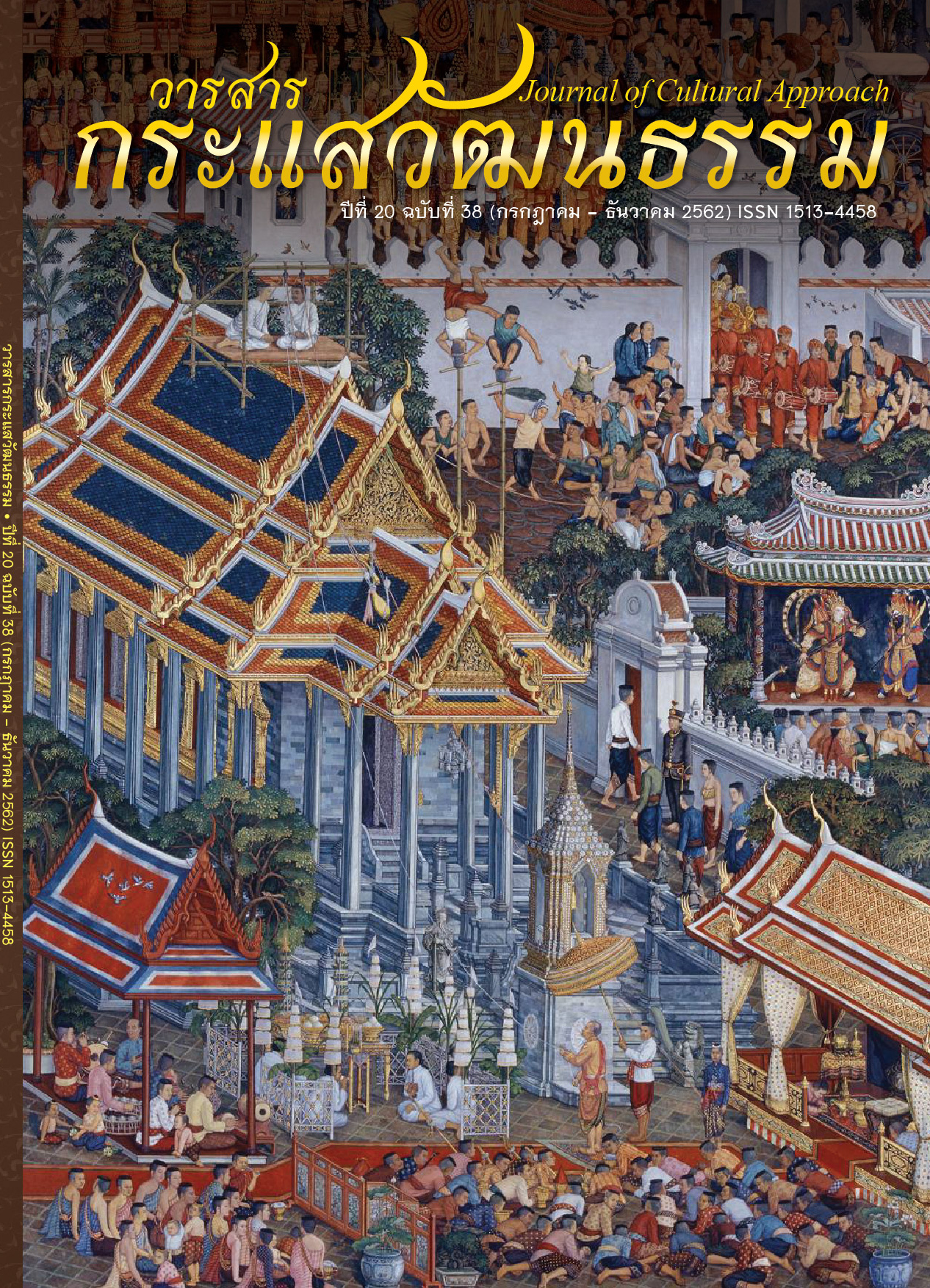การศึกษาองค์ความรู้และต่อยอดภูมิปัญญาพื้นบ้านในการใช้เครือซูดวัสดุธรรมชาติ เพื่อเศรษฐกิจสร้างสรรค์ในรูปแบบของเครื่องจักสาน
Main Article Content
บทคัดย่อ
การศึกษาองค์ความรู้และต่อยอดภูมิปัญญาพื้นบ้านในการใช้เครือซูดวัสดุธรรมชาติเพื่อเศรษฐกิจสร้างสรรค์ในรูปแบบของเครื่องจักสาน เป็นการวิจัยที่มีความมุ่งหมายสำคัญสองประการคือ (1) ศึกษาองค์ความรู้ ประวัติความเป็นมาและสภาพปัจจุบันปัญหาเกี่ยวกับภูมิปัญญาพื้นบ้านในการใช้เครือซูดตั้งแต่ขั้นตอน การปลูกขยายพันธุ์ การแปรรูปและ (2) เพื่อต่อยอดภูมิปัญญาพื้นบ้านในการใช้เครือซูดวัสดุธรรมชาติเพื่อเศรษฐกิจสร้างสรรค์ในรูปแบบของเครื่องจักสาน การศึกษาวิจัยครั้งนี้ใช้วิธีการวิจัยเชิงคุณภาพ (Qualitative Research) ได้แบ่งกลุ่มตัวอย่างเพื่อการเก็บรวบรวมข้อมูลเป็น 3 กลุ่มคือ 1) กลุ่มผู้รู้ 2) กลุ่มผู้เกี่ยวข้อง ผู้ปฏิบัติการและ 3) บุคคลทั่วไปรวมทั้งสิ้น 36 คน โดยการเก็บรวบรวมข้อมูลจากเอกสาร (Document) เก็บรวบรวมข้อมูลจากภาคสนาม (Field Study) ด้วยการสำรวจเบื้องต้นสัมภาษณ์แบบมีโครงสร้างและไม่มีโครงสร้าง สังเกตแบบมีส่วนร่วมและไม่มีส่วนร่วม การสนทนากลุ่ม และนำข้อมูลมาวิเคราะห์เพื่อหาทางที่จะตอบปัญหาตามวัตถุประสงค์ที่ตั้งไว้
ผลการศึกษาพบว่า ชุมชนบ้านกุดซุยมีเอกลักษณ์จากวัสดุที่ใช้ในการผลิตเครื่องจักสานหวาย และการนำวัสดุทดแทนหวายในท้องถิ่นมาใช้ด้วยการนำต้นเครือซูดซึ่งเป็นพืชตระกูลไม้เถา มีอยู่มากบริเวณป่าโคกป่าทามตามหัวไร่ปลายนามาสานแทนหวายช่างผู้ชำนาญในชุมชนสามารถที่จะสานหวายและต้นซูดออกมาได้หลาย Pattern ตามความต้องการของลูกค้า งานสั่งทำแต่ละตัวจะมีเอกลักษณ์เฉพาะไม่เหมือนใคร อย่างไรก็ตามลายที่ขายดีคือลายรังนก
การต่อยอดภูมิปัญญาพื้นบ้านในการใช้เครือซูดวัสดุธรรมชาติเพื่อเศรษฐกิจสร้างสรรค์ในรูปแบบของเครื่องจักสานพบว่า เครือซูดวัสดุธรรมชาติได้รับความนิยมนำมาผลิตเป็นอุปกรณ์เครื่องใช้ในครัวเรือนและเครื่องมือดักสัตว์หลายยุคหลายสมัย เมื่อนำมาผสมผสานกับงานดีไซน์ที่ได้รับการพัฒนาให้เป็นเฟอร์นิเจอร์ที่มีรูปแบบทันสมัยเพิ่มเสน่ห์ให้กับเครือซูดมากยิ่งขึ้น แต่ยังคงเน้นประโยชน์ใช้สอยเป็นหลัก โดยเฉพาะการนำงานเฟอร์นิเจอร์เครือซูดเข้ามาตกแต่งภายในบ้าน ซึ่งเป็นวัสดุธรรมชาติที่มีความแข็งแรงทนทาน มีอายุการใช้งานที่ยาวนาน แต่ขึ้นอยู่กับการใช้งานที่ต้องใช้ให้ถูกประเภท เช่นไม่ใช้วางของหนักๆ หรือปล่อยให้เฟอร์นิเจอร์หวายแท้ตากแดดตากฝน ซึ่งสิ่งเหล่านี้จะทำให้อายุของงานหวายแท้สั้นลง
โดยข้อสรุปต่างๆ ที่ได้กล่าวมานี้สามารถนำมาสร้างเป็นข้อกำหนดหรือขอบเขต เพื่อที่จะนำมาใช้เป็นกรอบแนวคิดในการออกแบบและสร้างรูปแบบผลิตภัณฑ์ใหม่ๆ ให้เกิดขึ้นที่ตรงตามเป้าหมายที่วางไว้ โดยข้อสรุปต่างๆ ที่ได้กล่าวมานี้สามารถนำมาสร้างเป็นข้อกำหนดหรือขอบเขต เพื่อที่จะนำมาใช้เป็นกรอบแนวคิดในการออกแบบและสร้างรูปแบบผลิตภัณฑ์ใหม่ๆ ให้เกิดขึ้นที่ตรงตามเป้าหมายที่วางไว้ การออกแบบเป็นการทำให้เกิดรูปทรงใหม่ขึ้นที่มีความสัมพันธ์กับความงามทางด้านศิลปะการออกแบบผลิตภัณฑ์ต้องคำนึงถึงหลักการต่อไปนี้
1. หน้าที่ใช้สอย (Function)
2. ความปลอดภัย (Safety)
3. ความแข็งแรง (Construction)
4. ความสะดวกสบายในการใช้ (Ergonomics)
5. ความสวยงามน่าใช้ (Aesthetics or Scale Appeal)
Article Details
Proposed Creative Commons Copyright Notices
1. Proposed Policy for Journals That Offer Open Access
Authors who publish with this journal agree to the following terms:
- Authors retain copyright and grant the journal right of first publication with the work simultaneously licensed under a Creative Commons Attribution License that allows others to share the work with an acknowledgement of the work's authorship and initial publication in this journal.
- Authors are able to enter into separate, additional contractual arrangements for the non-exclusive distribution of the journal's published version of the work (e.g., post it to an institutional repository or publish it in a book), with an acknowledgement of its initial publication in this journal.
- Authors are permitted and encouraged to post their work online (e.g., in institutional repositories or on their website) prior to and during the submission process, as it can lead to productive exchanges, as well as earlier and greater citation of published work (See The Effect of Open Access).
Proposed Policy for Journals That Offer Delayed Open Access
Authors who publish with this journal agree to the following terms:
- Authors retain copyright and grant the journal right of first publication, with the work [SPECIFY PERIOD OF TIME] after publication simultaneously licensed under a Creative Commons Attribution License that allows others to share the work with an acknowledgement of the work's authorship and initial publication in this journal.
- Authors are able to enter into separate, additional contractual arrangements for the non-exclusive distribution of the journal's published version of the work (e.g., post it to an institutional repository or publish it in a book), with an acknowledgement of its initial publication in this journal.
- Authors are permitted and encouraged to post their work online (e.g., in institutional repositories or on their website) prior to and during the submission process, as it can lead to productive exchanges, as well as earlier and greater citation of published work (See The Effect of Open Access).
เอกสารอ้างอิง
[2] Chantavanich, Supang. (2004). Qualitative Research Analysis. 6th ed. Bangkok: Chula Press.
[3] Department of Culture, Media and Sport. (2001). Creative Industries Mapping Document 2001. United Kingdom: London.
[4] Derby, D. A. (1980). Black Women Basket Makers : A Study of Domestic Economy in Charleston County, South Carolina. Doctoral Dissertation, University of Illinois, United States.
[5] Dozier, D. S. W. (2000). Kumeyaay Basketry: Resource Management as an Economic Strategy. Doctoral Dissertation, University of California, United States.
[6] Gold, J. R. (1980). An Introduction to Behavioral Geography. New York: Oxford University Press.
[7] Leesuwan, Viboon. (1996). Arts and Folk Crafts. 3rd ed. Bangkok: Tonaor–Grammy Press.
[8] Rattanapolsaen, Sopha. (2015, January 15). Interview. The Leader of Rattan Furniture Production Group. Ban Kut Sui, Lat Phattana, Mahasarakham.
[9] Saikwa, Sittipong. (2015, April 18). Interview. Chief Executive of the Sub–district Administrative Organization, Lat Phattana, Mahasarakham.
[10] Tinanon, Nuanlaor. (2001). The Study of Folkcrafts in Nakhon Nayok. Bangkok: Srinakharinwirot University.
[11] Whan. (2015, January 15). Interview. The Rattan Furniture Manufacturer. Ban Kut Sui, Lat Phattana, Mahasarakham.


